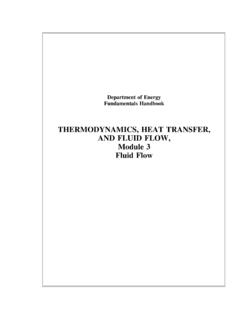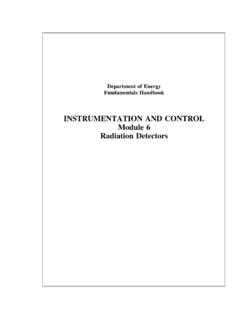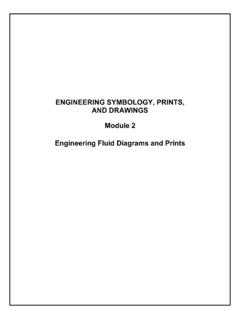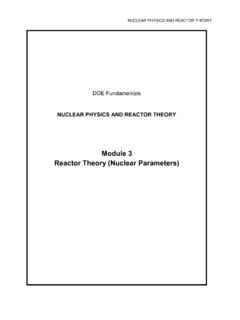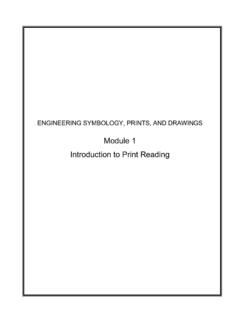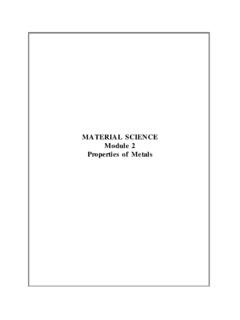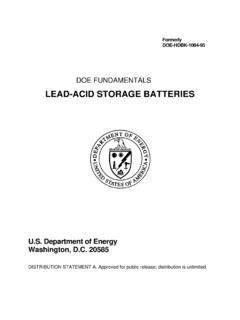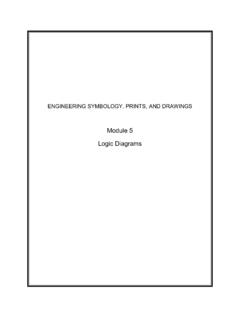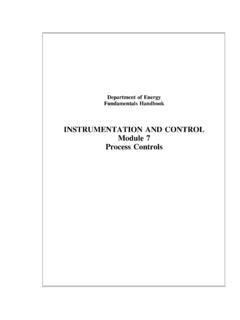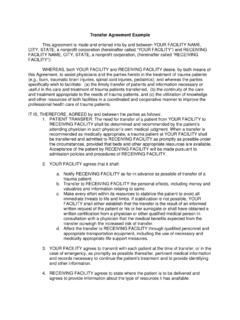Transcription of THERMODYNAMICS, HEAT TRANSFER, AND FLUID FLOW …
1 Department of EnergyFundamentals HandbookTHERMODYNAMICS, HEAT TRANSFER, AND FLUID FLOWM odule 1 ThermodynamicsThermodynamicsTABLE OF CONTENTSTABLE OF CONTENTSLIST OF ivLIST OF xTHERMODYNAMIC 1 Mass and 1 Specific 3 Specific 4 Intensive and Extensive 5 TEMPERATURE AND PRESSURE 6 Temperature 9 Pressure 12 ENERGY, WORK, AND 14 Potential 14 Kinetic 15 Specific Internal 16 Specific P-V 17 Specific 22 Energy and Power 25 Rev. 0 Page iHT-01 TABLE OF CONTENTST hermodynamicsTABLE OF CONTENTS (Cont.)THERMODYNAMIC SYSTEMS AND 26 Thermodynamic Systems and 26 Types of Thermodynamic 27 Thermodynamic 27 Control 27 Steady 27 Thermodynamic 28 Cyclic 28 Reversible 28 Irreversible 28 Adiabatic 29 Isentropic 29 Polytropic 29 Throttling 30 CHANGE OF 31 Classification of 33 Saturated and Subcooled 34 Moisture 35 Saturated and Superheated 35 Constant Pressure Heat 35 Critical 37 Triple 39 PROPERTY DIAGRAMS AND STEAM 41 Property 41 Pressure-Temperature (P-T) 42 Pressure-Specific Volume (P-v) 43 Pressure-Enthalpy (P-h) 44 Enthalpy-Temperature (h-T) 45HT-01 Page iiRev.
2 0 ThermodynamicsTABLE OF CONTENTSTABLE OF CONTENTS (Cont.)Temperature-Entropy (T-s) 46 Enthalpy-Entropy (h-s) or Mollier 47 Steam 52 FIRST LAW OF 53 First Law of 68 SECOND LAW OF 69 Second Law of 70 Carnot s 71 Carnot 71 Diagrams of Ideal and Real 77 Power Plant 78 Heat 85 Typical Steam 90 Causes of 96 COMPRESSION 97 Boyle s and Charles 97 Ideal Gas 99 Compressibility of 99 Constant Pressure Volume of Pressure Changes on FLUID of Temperature Changes on FLUID A A-1 Rev. 0 Page iiiHT-01 LIST OF FIGUREST hermodynamicsLIST OF FIGURESF igure 1 Comparison of Temperature 7 Figure 2 Pressure 9 Figure 3 Intensive 32 Figure 4 Piston-Cylinder 33 Figure 5 Vapor Pressure 33 Figure 6T-V Diagram Showing the Saturation 34 Figure 7T-V 35 Figure 8 Pressure-Temperature 38 Figure 9P-T Diagram for 42 Figure 10 P-v Diagram for 43 Figure 11 P-h Diagram for 44 Figure 12 h-T Diagram for 45 Figure 13 T-s Diagram for 46 Figure 14 First Law of 55 Figure 15 Control Volume 56 Figure 16 Open System Control 57 Figure 17 Open System Control Volumes (Cont.)
3 58 Figure 18 Mulitple Control Volumes in Same 58 Figure 19 T-s Diagram with Rankine 61HT-01 Page ivRev. 0 ThermodynamicsLIST OF FIGURESLIST OF FIGURES (Cont.)Figure 20 Typical Steam Plant 62 Figure 21 Carnot Cycle 73 Figure 22 Real Process Cycle Compared to Carnot 75 Figure 23 Control Volume for Second Law 76 Figure 24 Expansion and Compression Processes on T-s 78 Figure 25 Expansion and Compression Processes on h-s 78 Figure 26 Steam 78 Figure 27 Comparison of Ideal and Actual Turbine 80 Figure 28 Carnot 85 Figure 29 Carnot Cycle vs. Typical Power Cycle Available 86 Figure 30 Ideal Carnot 87 Figure 31 Rankine 88 Figure 32 Rankine Cycle with Real 89 Figure 33 Rankine Cycle Efficiencies 89 Figure 34 h-s 90 Figure 35 Typical Steam 91 Figure 36 Steam Cycle (Ideal).. 92 Figure 37 Steam Cycle (Real).. 92 Figure 38 Mollier 93 Figure 39 Ideal Gas Constant 98 Figure 40 Pressure-Volume 99 Rev.
4 0 Page vHT-01 LIST OF FIGUREST hermodynamicsLIST OF FIGURES (Cont.)Figure A-1 Mollier A-1 Figure A-2 Sample Steam A-3 Figure A-3 Thermodynamic Properties of A-5 Figure A-4 Thermodynamic Properties of viRev. 0 ThermodynamicsLIST OF TABLESLIST OF TABLESNONERev. 0 Page viiHT-01 REFERENCEST hermodynamicsREFERENCESVanWylen, G. J. and Sonntag, R. E., Fundamentals of Classical ThermodynamicsSI Version, 2nd Edition, John Wiley and Sons, New York, ISBN , Frank, Principles of Heat transfer , 3rd Edition, Intext Press, Inc., NewYork, ISBN , J. P., Thermodynamics, McGraw-Hill, New , Victor, L., FLUID Mechanics, 5th Edition, McGraw-Hill, New York, , W. C. and Perkins, H. C., Engineering Thermodynamics, 2nd Edition,McGraw-Hill, New York, ISBN , J. L., Engineering Mechanics Statics and Dynamics, John Wiley andSons, New York, ISBN , P. J. Conduction Heat transfer , Addison-Wesley Pub. Co., , J. P., Heat transfer , 3rd Edition, McGraw-Hill, New , J.
5 G. and Katz, D. L., FLUID Dynamics and Heat transfer , McGraw-Hill,New , W. and London, A. L., Compact Heat Exchangers, 2nd Edition, McGraw-Hill, New , J. A., Engineering Radiation Heat transfer , Holt, Rinehart and WinstonPublish., New , E. M. and Cess, R. E., Radiation Heat transfer , Brooks/Cole , Belmont, , D. C. and Morgan, N. R., Radiant-Interchange Configuration Factors,Tech. Note 2836, National Advisory Committee for viiiRev. 0 ThermodynamicsREFERENCESREFERENCES (Cont.)McDonald, A. T. and Fox, R. W., Introduction to FLUID mechanics, 2nd Edition,John Wiley and Sons, New York, ISBN , M. J. and Hoffman, J. D., Gas Dynamics , John Wiley and Sons,New York, ISBN Company, Flow of Fluids Through Valves, Fittings, and Pipe, Crane Paper No. 410, Chicago, Illinois, , Anthony, FLUID Power with Applications, Prentice-Hall, Inc., NewJersey, ISBN , T. G. and Buck, N. L., Mechanical Measurements, Addison-WesleyPublish Co.
6 , , Graham, One-Dimensional Two-Phase Flow, McGraw-Hill, New York, , W. and Crawford, M. E., Convective Heat and Mass transfer , McGraw-Hill, New York, ISBN , J. G., Convective Boiling and Condensation, McGraw-Hill, New York,ISBN Program for Nuclear Power Plant personnel , Volumes III and IV,Columbia, MD: General Physics Corporation, Library of Congress Card#A326517, , Virgel Moring and Simmang, Clifford Max, Thermodynamics, MacMillanPublishing Co. Inc., New 0 Page ixHT-01 OBJECTIVEST hermodynamicsTERMINAL operating conditions of a system,EVALUATEthe thermodynamic state of following following classifications of thermodynamic thermodynamic properties temperature and Fahrenheit, Celsius, Kelvin, and Rankine temperature scales zero freezing point of water at atmospheric boiling point of water at atmospheric between the Fahrenheit, Celsius, Kelvin, and Rankine relationship between absolute pressure, gauge pressure, and between the following per square of of of of used to measure heatHT-01 Page xRev.
7 0 ThermodynamicsOBJECTIVESENABLING OBJECTIVES (Cont.) following thermodynamic following types of thermodynamic following terms concerning thermodynamic following terms concerning thermodynamic intensive and extensive following pressure processes of sublimation, vaporization, condensation, and 0 Page xiHT-01 OBJECTIVEST hermodynamicsENABLING OBJECTIVES (Cont.) a Mollier diagram and sufficient information to indicate the state of the FLUID ,DETERMINEany unknown properties for the a set of steam tables and sufficient information to indicate the state of the FLUID ,DETERMINEany unknown properties for the change in the enthalpy of a FLUID as it passes through a systemcomponent, given the state of the FLUID at the inlet and outlet of the component and eithersteam tables or a Mollier First Law of the First Law of THERMODYNAMICS, ANALYZEan open system including allenergy transfer processes crossing the the First Law of THERMODYNAMICS, ANALYZE cyclic processes for athermodynamic a defined system,PERFORM energy balances on all major components in a heat exchanger,PERFORMan energy balance across the two sides of the path(s)
8 On a T-s diagram that represents the thermodynamic processesoccurring in a FLUID Second Law of the Second Law of THERMODYNAMICS, DETERMINEthe maximum possibleefficiency of a a thermodynamic system,CONDUCTan analysis using the Second Law a thermodynamic system,DESCRIBEthe method used to maximum efficiency of the efficiency of the components within the systemHT-01 Page xiiRev. 0 ThermodynamicsOBJECTIVESENABLING OBJECTIVES (Cont.) the path for an ideal process and that for a real process ona T-s or h-s a T-s or h-s diagram for a individual factors affect system or component the ideal gas laws toSOLVEfor the unknown pressure, temperature, or a FLUID may be considered to be work done in constant pressure and constant volume effects of pressure changes on confined effects of temperature changes on confined 0 Page xiiiHT-01 ThermodynamicsIntentionally Left BlankHT-01 Page xivRev.
9 0 ThermodynamicsTHERMODYNAMIC PROPERTIESTHERMODYNAMIC PROPERTIEST hermodynamic properties describe measurable characteristics of a knowledge of these properties is essential to the understanding the following the following classifications ofthermodynamic propertiesMass and WeightThemass(m) of a body is the measure of the amount of material present in that body. Theweight(wt) of a body is the force exerted by that body when its mass is accelerated in agravitational field. Mass and weight are related as shown in Equation =(1-1)mggcwhere:wt=weight (lbf)m=mass (lbm)g=acceleration of gravity = ft/sec2gc=gravitational constant = lbm-ft/lbf-sec2 Note that gchas the same numerical value as the acceleration of gravity at sea level, but is notthe acceleration of gravity. Rather, it is a dimensional constant employed to facilitate the use ofNewton s Second Law of Motion with the English system of weight of a body is a force produced when the mass of the body is accelerated by agravitational mass of a certain body will remain constant even if thegravitational acceleration acting upon that body 0 Page 1HT-01 THERMODYNAMIC PROPERTIEST hermodynamicsAccording to Newton s Second Law of Motion, force (F) = ma, where a is acceleration.
10 Forexample, on earth an object has a certain mass and a certain weight. When the same object isplaced in outer space, away from the earth s gravitational field, its mass is the same, but it isnow in a "weightless" condition (that is, gravitational acceleration and, thus, force equal zero).The English system uses the pound-force (lbf) as the unit of weight. Knowing that accelerationhas the units of ft/sec2and using Newton s second law, we can determine that the units of massare lbf-sec2/ft. For simplification, 1 lbf-sec2/ft is called a slug. The basic unit of mass in theEnglish system is the slug. However, the slug is an almost meaningless unit for the averageindividual. The unit of mass generally used is the pound-mass (lbm). In order to allow lbm tobe used as a unit of mass, we must divide Newton s second law by the gravitational constant (gc). s second law can be expressed by Equation 1-2.(1-2)FmagcUse of the gravitational constant, gc, adapts Newton s second law such that 1 lbf = 1 lbm at thesurface of the earth.
